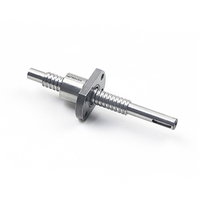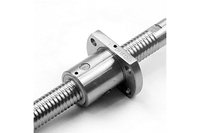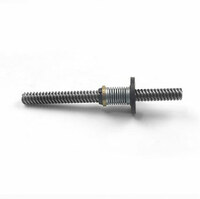Linear Motion Lead Screws
Specifications
Provided by a professional custom lead screws manufacturer, VXO high precision lead screws supplier is an excellent economical solution for your linear motion requirements. For more than 15 years,
VXO high precision lead screws supplier has designed and manufactured the highest-quality linear motion lead screws in the industry. Our high precision lead screws ensure accurate positioning and
product lead time is 7-15 days. We also produce Trapezoidal thread, Unified screw thread, ACME screw thread, special Pitch, and multiple start thread. For lead nut and lead screw nut assembly,
configuration is not restricted and it is possible to manufacture in accordance with the customer's design.
Custom High Precision Linear Lead Screws
No other linear motion lead screws combines the speed, accuracy, efficiency, repeatability, quiet operation, lubrication retention, load capacity, and compactness of VXO custom high precision
linear lead screws. Our lead nuts are available in a standard threaded or flanged mounting configuration, and anti-backlash nuts provide the best positional repeatability.
Using Linear Motions Lead Screws Advantages
Linear motion lead screws have many advantages among linear motion units – some of these are;
High load-carrying capacity
Compact
Easy to design into a system
Minimal number of parts
Smooth operation
Quiet
Require little maintenance
What Is The Difference Between A Linear Lead Screws And Ball Screws?
Linear ball screw and linear lead screws can sometimes be used in the same applications. Typically, ball lead screw cnc are used in industry applications that need a lot of load or life while
linear lead screws are used in smaller, lighter duty applications.
In VXO lead screw supplier, High precision Linear lead screws however are highly customizable with the ability to interchange leads, sizes, and nut configurations quickly. The cost of custom lead
screw is usually not the primary consideration when selecting a screw technology.
What Is The Difference Between A Linear Lead Screws And Ball Screws?
High Precision Lead Screws Maintaince
According to VXO lead screw supplier, Here are some tips for maintaining high precision lead screws:
1. Keep the high precision lead screws lubricated: Lubrication is essential for the smooth operation of lead screws. Make sure to use the appropriate lubricant and apply it regularly.
2. Clean the high precision lead screws: Dirt and debris can accumulate on the lead screw, causing it to wear down faster. Regular cleaning with a soft cloth or brush can help prevent this.
3. Check for wear and tear: Over time, high precision lead screws can become worn or damaged. Regularly inspecting the high precision lead screws for signs of wear or damage can help prevent
further problems.
4. Tighten loose connections: Loose connections can cause the lead screw to wobble or vibrate, which can lead to premature wear. Check for loose connections and tighten them as needed.
5. Replace worn components: If any components of the high precision lead screws are worn or damaged, it's important to replace them promptly. This can help prevent further damage and ensure the
smooth operation of the high precision lead screws.
High Precision Lead Screws Design
In VXO lead screw supplier, Lead screw design involves determining the appropriate dimensions and specifications for a high precision lead screw, which is a type of screw used to convert rotary
motion into linear motion. The design process typically involves the following steps:
1. Determine the application requirements: This involves identifying the load, speed, and accuracy requirements for the high precision lead screw. These factors will impact the selection of
materials, thread pitch, and other design parameters.
2. Select the appropriate materials: The materials used for the high precision lead screw and nut must be able to withstand the loads and stresses involved in the application. Common materials
include steel, bronze, and plastic.
3. Determine the thread pitch: The thread pitch is the distance between adjacent threads on the high precision lead screw. It is determined based on the required linear speed and the rotational
speed of the screw.
4. Calculate the lead angle: The lead angle is the angle between the helix of the high precision lead screw and a plane perpendicular to the axis of rotation. It is determined based on the thread
pitch and the diameter of the lead screw.
5. Determine the diameter of the high precision lead screw: The diameter of the lead screw is determined based on the load requirements and the strength of the materials used.
6. Design the nut: The nut is the component that engages with the high precision lead screw and converts the rotary motion into linear motion. The design of the nut is determined based on the
thread pitch and the materials used.
7. Calculate the critical speed: The critical speed is the rotational speed at which the high precision lead screw will vibrate and potentially fail. It is determined based on the length, diameter,
and materials of the high precision lead screw.
8. Verify the design: The final step is to verify the design using simulations or testing to ensure that it meets the application requirements and can withstand the expected loads and stresses.
Lead Screw Manufacturing Process At Linear Lead Screw Suppiers
As our linear motion lead screws infographic illustrates, the manufacturing of linear motion lead screws requires a complex high precision lead screw manufacturing process. Initially, that process
begins with the O.D. grind of raw material down to tolerances measured to a maximum of 0.0005 inches (12 µm). After the initial grind-down, as a professional linear motion manufacturer, we then
utilize a precision German CNC roll threader to ensure strong and accurate thread forms.
In VXO lead screw supplier, During the roll threading operation, our CNC-controlled machinery incorporates precision process adjustments and controls while employing automated in-feed and outfeed
features. Together, these provide consistency over the full length of the linear lead screw stock. In addition, our roll threading machine's progressive dies control raw material flow by
manipulating speed, skew, and temperature. These key process variables are precisely monitored to ensure the highest level of lead accuracy.
High Precision Lead Screws Material
In VXO lead screw supplier, High precision lead screws can be made from a variety of materials, depending on the application and required properties. Some common materials used for lead screws
include:
1. Stainless steel: This material is commonly used for High precision lead screws because it is corrosion-resistant and has good strength and durability. SS303(1.4305), SS304(1.4301), SS316,
SS316L, SS440C, SUS631
2. Carbon steel: This material is less expensive than stainless steel and is often used for applications that do not require high corrosion resistance. Q235, C45, 40Cr, A3, S55C, 42CrMnTi, C45Pb
3. Bronze: This material is used for High precision lead screws that require high wear resistance and low friction.
4. Aluminum: This material is lightweight and has good corrosion resistance, but is not as strong as other materials and is typically used for low-load applications.
5. Plastics: Various plastics, such as acetal, nylon, and PEEK, can be used for high precision lead screws in applications that require low friction and high wear resistance.
The choice of material will depend on factors such as the load capacity, speed, accuracy, and environmental conditions of the application.
High Precision Linear Motion Lead Screws Application
In VXO lead screw supplier, Linear motion lead screws are often used in linear actuators, machine tools, screw jacks, presses and vises.
Linear motion lead screws are also found in biomedical environments such as clinics and hospitals. For example, high linear lead screws are used in pumps for blood and drugs requiring precise fluid
measurement and fluid delivery. They are also used in lab testing equipment such as devices that sample, scan and handle fluid.
Other popular industries in which linear motion lead screws sets are used include defense, transport and industrial automation.
What are high precision lead screws used for?
High Precision Lead screws are used in various applications where precise linear motion and positioning are required. Some common lead screw applications of lead screws include:
Machine Tools: High Precision Lead screws play a crucial role in machine tools such as lathes, milling machines, and drill presses. They enable controlled movement of the tool carriage, allowing
for precise cutting, shaping, and drilling operations.
3D Printers: High Precision Lead screws are commonly employed in 3D printers to control the movement of the print head or build plate. Take 3D printer z axis lead screw as an instance, they ensure
accurate positioning and smooth motion, resulting in high-quality prints.
CNC Machines: Computer Numerical Control (CNC) machines utilize High Precision lead screws to drive the axes of movement. Lead screws such as CNC 3018 lead screw enable precise and repeatable
positioning of the cutting tool, ensuring accurate machining processes.
Robotics: High Precision Lead screws are extensively used in robotic systems for actuation and motion control. They enable precise movement of robotic arms, grippers, and other components, allowing
robots to perform intricate tasks with accuracy.
Industrial Automation: High Precision Lead screws find applications in various industrial automation systems, such as material handling equipment, assembly lines, and packaging machinery. They
provide reliable and precise linear motion for efficient and controlled processes.
These are just a few examples of the diverse range of applications where High Precision lead screws are used. Overall, High Precision lead screws are valued for their ability to convert rotational
motion into precise linear motion, making them essential components in numerous industries requiring controlled movement and positioning.
Linear lead screws function
The linear lead screw of a lathe is used to advance the carriage of the lathe in time with the rotation of the spindle. It is used to make threads by having different gearing between the spindle
and the drive for the High Precision lead screw.
The primary function of a linear lead screw is to transform the rotary motion applied to the High Precision lead screw into linear motion along its axis. As the lead screw rotates, the threaded nut
moves along the screw's thread, causing linear displacement. This linear displacement can be utilized to move or position various mechanical components or objects.
How to use linear motion lead screws?
Linear motion lead screw in the lathe are used while cutting threads on a job. For thread cutting the feed of the cutting tool should be in correspondence with the rotational speed (rpm) of
chuck/workpiece which is different for different threads spec. The RPM of the spindle is based on the gear settings in the gearbox.
Thus for a particular thread type, the gear set is done than half out of the carriage is engaged with the linear motion lead screws, which enables the carriage to move /take power from the linear
motion lead screws.
If you need any kinds of linear motion components, please contact us, as a professional linear bearing supplier, VXO is willing to offer you high quality products.
- Country: China (Mainland)
- Business Type: Manufacturer
- Founded Year: 2011
- Address: 5/F, Bldg. B, Baodai Sci-Tech Park, 988 Wusong Road,Wuzhong Dist, Suzhou, Jiangsu
- Contact: vxolinear motion










